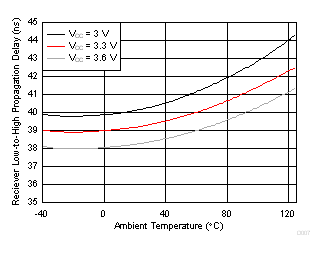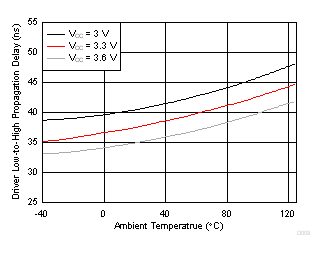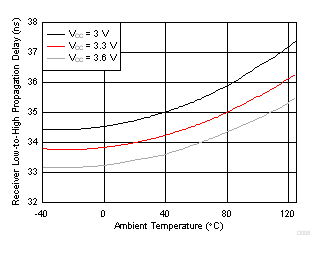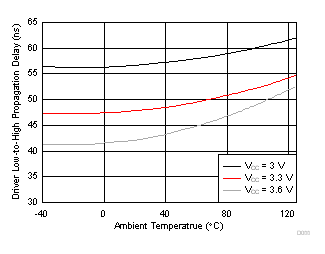ZHCSFG5A September 2016 – November 2016 SN65HVD233-Q1 , SN65HVD234-Q1 , SN65HVD235-Q1
PRODUCTION DATA.
- 1 特性
- 2 应用
- 3 说明
- 4 修订历史记录
- 5 说明 (续)
- 6 Device Comparison Table
- 7 Pin Configuration and Functions
-
8 Specifications
- 8.1 Absolute Maximum Ratings
- 8.2 ESD Ratings
- 8.3 Recommended Operating Conditions
- 8.4 Thermal Information
- 8.5 Electrical Characteristics: Driver
- 8.6 Electrical Characteristics: Receiver
- 8.7 Switching Characteristics: Driver
- 8.8 Switching Characteristics: Receiver
- 8.9 Switching Characteristics: Device
- 8.10 Typical Characteristics
- 9 Parameter Measurement Information
- 10Detailed Description
- 11Application and Implementation
- 12Power Supply Recommendations
- 13Layout
- 14器件和文档支持
- 15机械、封装和可订购信息
8 Specifications
8.1 Absolute Maximum Ratings
over operating ambient temperature range unless otherwise noted(1)(2)| MIN | MAX | UNIT | ||||
|---|---|---|---|---|---|---|
| VCC | Supply voltage | –0.3 | 7 | V | ||
| Voltage at any bus terminal (CANH or CANL) | –36 | 36 | V | |||
| Voltage input, transient pulse, CANH and CANL, through 100 Ω (see Figure 18) | –100 | 100 | V | |||
| VI | Input voltage, (AB, EN, LBK, RS, TXD) | –0.5 | 7 | V | ||
| VO | Output voltage (RXD) | –0.5 | 7 | V | ||
| IO | Receiver output current | –10 | 10 | mA | ||
| TJ | Operating junction temperature | –40 | 150 | °C | ||
| Tstg | Storage temperature | 125 | °C | |||
(1) Stresses beyond those listed under Absolute Maximum Ratings may cause permanent damage to the device. These are stress ratings only, and functional operation of the device at these or any other conditions beyond those indicated under Recommended Operating Conditions is not implied. Exposure to absolute-maximum-rated conditions for extended periods may affect device reliability.
(2) All voltage values, except differential I/O bus voltages, are with respect to the network ground pin.
8.2 ESD Ratings
| VALUE | UNIT | ||||
|---|---|---|---|---|---|
| V(ESD) | Electrostatic discharge | Human-body model (HBM), per AEC Q100-002(1) | CANH, CANL to GND | ±12 000 | V |
| Between CANH and CANL | ±16 000 | ||||
| All pins | ±3 000 | ||||
| Charged-device model (CDM), per AEC Q100-011 | ±1 000 | ||||
(1) AEC Q100-002 indicates that HBM stressing shall be in accordance with the ANSI/ESDA/JEDEC JS-001 specification.
8.3 Recommended Operating Conditions
| MIN | MAX | UNIT | |||
|---|---|---|---|---|---|
| VCC | Supply voltage | 3 | 3.6 | V | |
| Voltage at any bus terminal (separately or common mode) | –7 | 12 | V | ||
| VIH | High-level input voltage | EN, AB, LBK, TXD | 2 | 5.5 | V |
| VIL | Low-level input voltage | EN, AB, LBK, TXD | 0 | 0.8 | V |
| VID | Differential input voltage between CANH and CANL | –6 | 6 | V | |
| Resistance from RS to ground | 0 | 100 | kΩ | ||
| VI(Rs) | Input voltage at RS for standby | 0.75 VCC | 5.5 | V | |
| IOH | High-level output current | Driver | –50 | mA | |
| Receiver | –10 | ||||
| IOL | Low-level output current | Driver | 50 | mA | |
| Receiver | 10 | ||||
| TA | Operating ambient temperature(1) | –40 | 125 | °C | |
(1) Maximum ambient temperature operation is allowed as long as the device maximum junction temperature is not exceeded.
8.4 Thermal Information
| THERMAL METRIC(1) | SN65HVD23x-Q1 | UNIT | |
|---|---|---|---|
| D (SOIC) | |||
| 8 PINS | |||
| RθJA | Junction-to-ambient thermal resistance | 102.8 | °C/W |
| RθJC(top) | Junction-to-case (top) thermal resistance | 45.1 | °C/W |
| RθJB | Junction-to-board thermal resistance | 43.8 | °C/W |
| ψJT | Junction-to-top characterization parameter | 7.3 | °C/W |
| ψJB | Junction-to-board characterization parameter | 43.2 | °C/W |
(1) For more information about traditional and new thermal metrics, see the Semiconductor and IC Package Thermal Metrics application report, SPRA953.
8.5 Electrical Characteristics: Driver
over operating ambient temperature range (unless otherwise noted)| PARAMETER | TEST CONDITIONS | MIN | TYP(1) | MAX | UNIT | |||
|---|---|---|---|---|---|---|---|---|
| VO(D) | Bus output voltage (dominant) | CANH | TXD at 0 V, RS at 0 V, see Figure 12 and Figure 13 | 2.45 | VCC | V | ||
| CANL | 0.5 | 1.25 | ||||||
| VO | Bus output voltage (recessive) | CANH | TXD at 3 V, RS at 0 V, see Figure 12 and Figure 13 | 2.3 | V | |||
| CANL | 2.3 | |||||||
| VOD(D) | Differential output voltage (dominant) | TXD at 0 V, RS at 0 V, see Figure 12 and Figure 13 | 1.5 | 2 | 3 | V | ||
| TXD at 0 V, RS at 0 V, see Figure 13 and Figure 14 | 1.2 | 2 | 3 | |||||
| VOD | Differential output voltage (recessive) | TXD at 3 V, RS at 0 V, see Figure 12 and Figure 13 | –120 | 12 | mV | |||
| TXD at 3 V, RS at 0 V, no load | –0.5 | 0.05 | V | |||||
| VOC(pp) | Peak-to-peak common-mode output voltage | See Figure 21 | 1 | V | ||||
| IIH | High-level input current | AB, EN, LBK, TXD | TXD = 2 V or EN = 2 V or LBK = 2 V or AB = 2 V | –30 | 30 | μA | ||
| IIL | Low-level input current | AB, EN, LBK, TXD | TXD = 0.8 V or EN = 0.8 V or LBK = 0.8 V or AB = 0.8 V | –30 | 30 | μA | ||
| IOS | Short-circuit output current | VCANH = –7 V, CANL open, see Figure 26 | –250 | mA | ||||
| VCANH = 12 V, CANL open, see Figure 26 | 1 | |||||||
| VCANL = –7 V, CANH open, see Figure 26 | –1 | |||||||
| VCANL = 12 V, CANH open, see Figure 26 | 250 | |||||||
| CO | Output capacitance | See CI, Input capacitance in Electrical Characteristics: Receiver | ||||||
| IIRs(s) | RS input current for standby | RS at 0.75 VCC | –10 | μA | ||||
| ICC | Supply current | Sleep | EN at 0 V, TXD at VCC, RS at 0 V or VCC | 0.05 | 2 | μA | ||
| Standby | RS at VCC, TXD at VCC, AB at 0 V, LBK at 0 V, EN at VCC |
200 | 600 | |||||
| Dominant | TXD at 0 V, no load, AB at 0 V, LBK at 0 V, RS at 0 V, EN at VCC |
6 | mA | |||||
| Recessive | TXD at VCC, no load, AB at 0 V, LBK at 0 V, RS at 0 V, EN at VCC |
6 | ||||||
| P(AVG) | Average power dissipation | RL = 60 Ω, RS at 0 V, input to D a 1-MHz 50% duty cycle square wave VCC at 3.3 V, TA = 25°C |
36.4 | mW | ||||
(1) All typical values are at 25°C and with a 3.3-V supply.
8.6 Electrical Characteristics: Receiver
over operating ambient temperature range (unless otherwise noted)| PARAMETER | TEST CONDITIONS | MIN | TYP(1) | MAX | UNIT | |||
|---|---|---|---|---|---|---|---|---|
| VIT+ | Positive-going input threshold voltage | AB at 0 V, LBK at 0 V, EN at VCC, see Table 1 | 750 | 900 | mV | |||
| VIT– | Negative-going input threshold voltage | 500 | 650 | mV | ||||
| Vhys | Hysteresis voltage (VIT+ – VIT–) | 100 | mV | |||||
| VOH | High-level output voltage | IO = –4 mA, See Figure 17 | 0.8 × VCC | V | ||||
| VOL | Low-level output voltage | IO = 4 mA, See Figure 17 | 0.4 | V | ||||
| II | Bus input current | CANH or CANL at 12 V | Other bus pin at 0 V, TXD at 3 V, AB at 0 V, LBK at 0 V, RS at 0 V, EN at VCC |
150 | 500 | μA | ||
| CANH or CANL at 12 V, VCC at 0 V |
200 | 600 | ||||||
| CANH or CANL at –7 V | –610 | –150 | ||||||
| CANH or CANL at –7 V, VCC at 0 V |
–450 | –130 | ||||||
| CI | Input capacitance (CANH or CANL) | Pin-to-ground, VI = 0.4 sin (4E6πt) + 0.5 V, TXD at 3 V, AB at 0 V, LBK at 0 V, EN at VCC |
40 | pF | ||||
| CID | Differential input capacitance | Pin-to-pin, VI = 0.4 sin (4E6πt) + 0.5 V, TXD at 3 V, AB at 0 V, LBK at 0 V, EN at VCC |
20 | pF | ||||
| RID | Differential input resistance | TXD at 3 V, AB at 0 V, LBK at 0 V, EN at VCC | 40 | 100 | kΩ | |||
| RIN | Input resistance (CANH or CANL) to ground | 20 | 50 | kΩ | ||||
| ICC | Supply current | Sleep | EN at 0 V, TXD at VCC, RS at 0 V or VCC | 0.05 | 2 | μA | ||
| Standby | RS at VCC, TXD at VCC, AB at 0 V, LBK at 0 V, EN at VCC | 200 | 600 | |||||
| Dominant | TXD at 0 V, no load, RS at 0 V, LBK at 0 V, AB at 0 V, EN at VCC |
6 | mA | |||||
| Recessive | TXD at VCC, no load, RS at 0 V, LBK at 0 V, AB at 0 V, EN at VCC |
6 | ||||||
(1) All typical values are at 25°C and with a 3.3-V supply.
8.7 Switching Characteristics: Driver
over operating ambient temperature range (unless otherwise noted)| PARAMETER | TEST CONDITIONS | MIN | TYP(1) | MAX | UNIT | |
|---|---|---|---|---|---|---|
| tPLH | Propagation delay time, low-to-high-level output |
RS at 0 V, see Figure 15 | 35 | 85 | ns | |
| RS with 10 kΩ to ground, see Figure 15 | 70 | 125 | ||||
| RS with 100 kΩ to ground, see Figure 15 | 500 | 870 | ||||
| tPHL | Propagation delay time, high-to-low-level output |
RS at 0 V, see Figure 15 | 70 | 120 | ns | |
| RS with 10 kΩ to ground, see Figure 15 | 130 | 180 | ||||
| RS with 100 kΩ to ground, see Figure 15 | 870 | 1200 | ||||
| tsk(p) | Pulse skew (|tPHL – tPLH|) | RS at 0 V, see Figure 15 | 35 | ns | ||
| RS with 10 kΩ to ground, see Figure 15 | 60 | |||||
| RS with 100 kΩ to ground, see Figure 15 | 370 | |||||
| tr | Differential output signal rise time | RS at 0 V, see Figure 15 | 20 | 70 | ns | |
| RS with 10 kΩ to ground, see Figure 15 | 30 | 135 | ||||
| RS with 100 kΩ to ground, see Figure 15 | 350 | 1400 | ||||
| tf | Differential output signal fall time | RS at 0 V, see Figure 15 | 20 | 70 | ns | |
| RS with 10 kΩ to ground, see Figure 15 | 30 | 135 | ||||
| RS with 100 kΩ to ground, see Figure 15 | 350 | 1400 | ||||
| ten(s) | Enable time from standby to dominant | See Figure 19 and Figure 20 | 0.6 | 1.5 | μs | |
| ten(z) | Enable time from sleep to dominant | 1 | 5 | μs | ||
(1) All typical values are at 25°C and with a 3.3-V supply.
8.8 Switching Characteristics: Receiver
over operating ambient temperature range (unless otherwise noted)| PARAMETER | TEST CONDITIONS | MIN | TYP(1) | MAX | UNIT | |
|---|---|---|---|---|---|---|
| tPLH | Propagation delay time, CANH input low to RXD output high | See Figure 17 | 35 | 60 | ns | |
| tPHL | Propagation delay time, CANH input high to RXD output low | 35 | 60 | ns | ||
| tsk(p) | Pulse skew (|tPHL – tPLH|) | 7 | ns | |||
| tr | Output signal rise time | 2 | 5 | ns | ||
| tf | Output signal fall time | 2 | 5 | ns | ||
(1) All typical values are at 25°C and with a 3.3-V supply.
8.9 Switching Characteristics: Device
over operating ambient temperature range (unless otherwise noted)| PARAMETER | TEST CONDITIONS | MIN | TYP(1) | MAX | UNIT | ||
|---|---|---|---|---|---|---|---|
| t(LBK) | Loopback delay, driver input to receiver output | 'HVD233-Q1 | See Figure 23 | 7.5 | 12 | ns | |
| t(AB1) | Loopback delay, driver input to receiver output | 'HVD235-Q1 | See Figure 24 | 10 | 20 | ns | |
| t(AB2) | Loopback delay, bus input to receiver output |
See Figure 25 | 35 | 60 | ns | ||
| t(loop1) | Total loop delay, driver input to receiver output, recessive to dominant | RS at 0 V, see Figure 22 | 70 | 135 | ns | ||
| RS with 10 kΩ to ground, see Figure 22 | 105 | 190 | |||||
| RS with 100 kΩ to ground, see Figure 22 | 535 | 1000 | |||||
| t(loop2) | Total loop delay, driver input to receiver output, dominant to recessive | RS at 0 V, see Figure 22 | 70 | 135 | ns | ||
| RS with 10 kΩ to ground, see Figure 22 | 105 | 190 | |||||
| RS with 100 kΩ to ground, see Figure 22 | 535 | 1000 | |||||
(1) All typical values are at 25°C and with a 3.3-V supply.
8.10 Typical Characteristics
RS = LBK = AB = 0 V; EN = VCC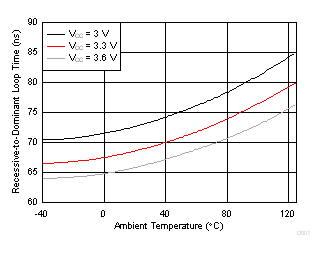
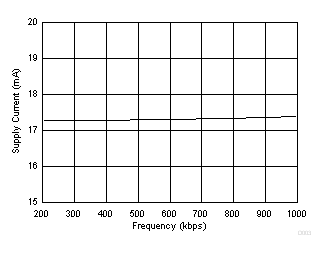
| VCC = 3.3 V | TA = 25°C | RL = 60-Ω Load |
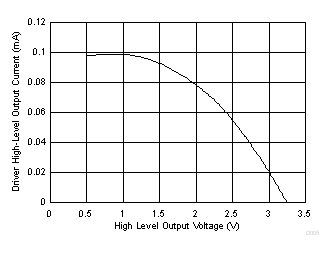
| VCC = 3.3 V | TA = 25°C |
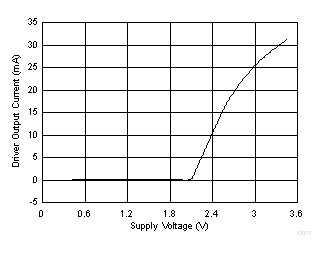
| TA = 25°C | RL = 60 Ω |
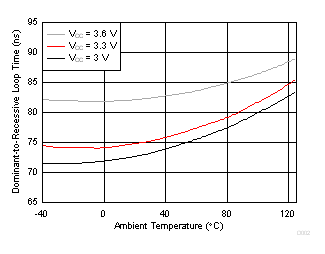
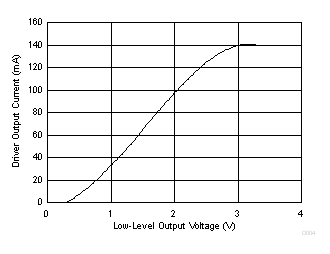
| VCC = 3.3 V | TA = 25°C |
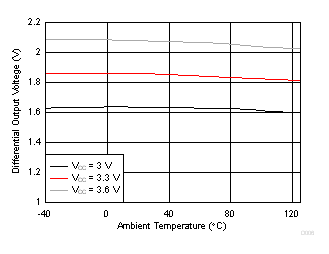
| RL = 60 Ω |
